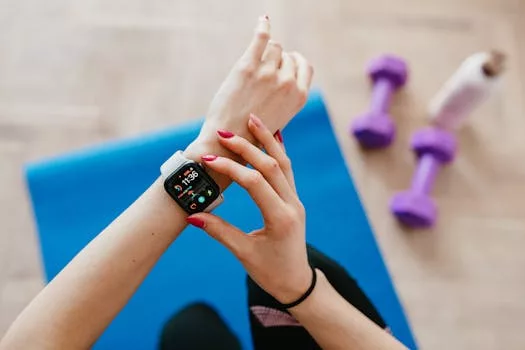
“
Wearable Tech: The Expanding Role in Everyday Life by 2025
Wearable Tech is no longer just about fitness tracking. The technology has expanded its role in everyday life, from healthcare to personal development. With the rise of smartwatches, fitness trackers, and other wearable devices, people are now using these gadgets to monitor their health, track their daily activities, and even manage their stress levels. For insights on future innovations, check out Futuristic Features: What to Expect from Wearable Tech Innovations in 2025.
The Evolution of Wearable Tech
The concept of wearable tech has been around for decades, but it wasn’t until the release of the first smartwatch in 2010 that the industry started to gain traction. Since then, we’ve seen a proliferation of wearable devices, from fitness trackers to smart glasses. Today, wearable tech is a multi-billion-dollar industry, with millions of people around the world using these devices to monitor their health and fitness. For a deeper dive into how wearable tech is bridging the gap between health and technology, read Wearable Tech in 2025: Bridging the Gap Between Health and Technology.
Applications of Wearable Tech Beyond Fitness
While fitness tracking is still one of the primary uses of wearable tech, the devices are now being used for a variety of other applications. Some of these include:
- Health Monitoring: Wearable devices can now track a range of health metrics, including heart rate, blood pressure, and sleep quality.
- Stress Management: Many wearable devices now come with built-in stress tracking features, which can help users identify and manage stress.
- Personal Development: Wearable devices can be used to track daily habits, set reminders, and even provide motivational quotes to help users stay focused and motivated.
- Navigation: Many wearable devices now come with GPS capabilities, making it easy for users to navigate their surroundings.
The Future of Wearable Tech
As we look to the future, it’s clear that wearable tech will continue to play an increasingly important role in our daily lives. With advances in technology, we can expect to see even more sophisticated devices that can track a range of health and fitness metrics. Some of the trends that we can expect to see in the future include:
- Increased Adoption of Smartwatches: Smartwatches are expected to become even more popular in the coming years, with many users opting for these devices over traditional fitness trackers.
- Advances in Health Monitoring: We can expect to see even more advanced health monitoring features in wearable devices, including the ability to track blood glucose levels and other health metrics.
- Greater Integration with Other Devices: Wearable devices will become even more integrated with other devices, such as smartphones and home automation systems.
Conclusion
Wearable tech has come a long way in recent years, and it’s clear that these devices will continue to play an increasingly important role in our daily lives. From healthcare to personal development, wearable devices are now being used for a range of applications beyond fitness tracking. As we look to the future, it’s exciting to think about the possibilities that wearable tech holds, and how these devices will continue to shape and improve our lives. For more insights on innovations that will change our interactions with the world, visit Wearable Tech 2025: Innovations That Will Change How We Interact with the World.
Impact of Wearable Tech on Society
The impact of wearable tech on society is multifaceted. On one hand, these devices have the potential to greatly improve our health and wellness, by providing us with the data and insights we need to make informed decisions about our lifestyles. On the other hand, there are also concerns about the impact of wearable tech on our mental health, with some critics arguing that the constant stream of data and notifications can be overwhelming and stressful.
Benefits of Wearable Tech
There are many benefits to using wearable tech, including:
- Improved Health Outcomes: Wearable devices can help us track our health and fitness, and provide us with the insights we need to make informed decisions about our lifestyles.
- Increased Motivation: Wearable devices can provide us with the motivation we need to stay active and engaged, by tracking our progress and providing us with rewards and incentives.
- Enhanced Convenience: Wearable devices can provide us with a range of convenient features, from mobile payments to music control.
Challenges and Limitations of Wearable Tech
While wearable tech has the potential to greatly improve our lives, there are also several challenges and limitations to consider. Some of these include:
- Accuracy and Reliability: Wearable devices are not always accurate or reliable, and can provide us with inaccurate or misleading data.
- Security and Privacy: Wearable devices can pose security and privacy risks, particularly if they are connected to the internet or other devices.
- Cost and Accessibility: Wearable devices can be expensive, and may not be accessible to everyone, particularly in developing countries or low-income communities.
Real-World Applications of Wearable Tech
Wearable tech has a range of real-world applications, from healthcare to education. Some examples include:
- Healthcare: Wearable devices are being used in healthcare to track patient outcomes, monitor chronic conditions, and provide remote care.
- Education: Wearable devices are being used in education to track student engagement, provide personalized learning experiences, and enhance classroom instruction.
- Workplace: Wearable devices are being used in the workplace to track employee productivity, provide safety training, and enhance workflow efficiency.
Case Studies of Wearable Tech in Action
There are many examples of wearable tech in action, from healthcare to education. Some case studies include:
- Remote Patient Monitoring: Wearable devices are being used to remotely monitor patients with chronic conditions, such as diabetes or heart failure.
- Personalized Learning: Wearable devices are being used to provide personalized learning experiences for students, by tracking their engagement and providing real-time feedback.
- Industrial Safety: Wearable devices are being used to enhance industrial safety, by providing workers with real-time alerts and warnings about potential hazards.
Future Directions for Wearable Tech
As we look to the future, it’s clear that wearable tech will continue to evolve and improve. Some potential future directions for wearable tech include:
- Advances in Materials Science: New materials and technologies, such as nanotechnology and biotechnology, will enable the development of more sophisticated and effective wearable devices.
- Increased Focus on User Experience: Wearable devices will need to be designed with the user experience in mind, providing intuitive and seamless interactions.
- Greater Integration with Other Technologies: Wearable devices will need to be integrated with other technologies, such as artificial intelligence and blockchain, to provide more comprehensive and effective solutions.
Conclusion
Wearable tech has the potential to greatly improve our lives, from healthcare to personal development. As we look to the future, it’s exciting to think about the possibilities that wearable tech holds, and how these devices will continue to shape and improve our lives. With advances in technology and design, wearable devices will become even more sophisticated and effective, providing us with the insights and tools we need to live healthier, happier, and more fulfilling lives.


